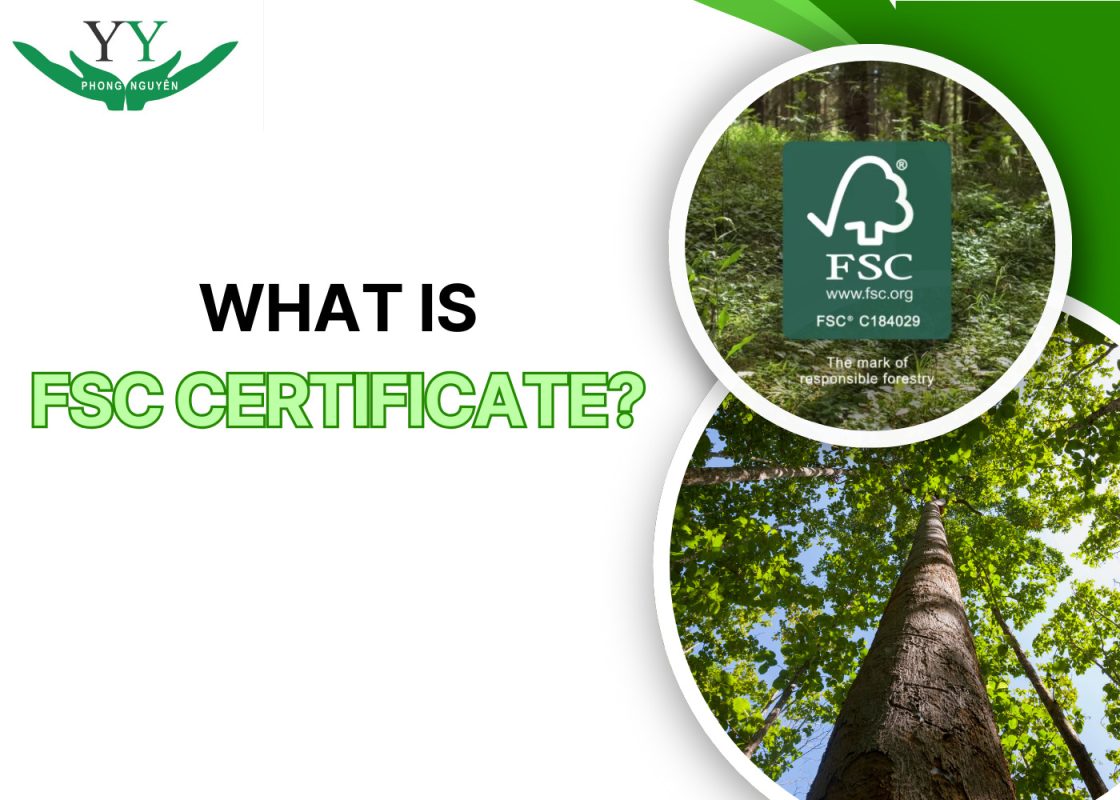As environmental awareness grows, both businesses and consumers are leaning toward eco-friendly products. In this trend, FSC certification has become a global symbol of sustainable and trustworthy forest management. So, what is FSC certificate?
What is FSC Certificate?
FSC certificate (Forest Stewardship Council) is an international certificate that ensures forest-based products (such as wood, paper, bamboo, etc.) are harvested and produced responsibly in terms of environmental, social, and economic factors.

FSC is a non-governmental international organization founded in 1993 with a mission to promote responsible forest management worldwide. For businesses, FSC certification enhances brand image, opens access to international markets, and meets the requirements of major partners.
Purpose of FSC Certificate
FSC was established to address the urgent issue of global forest degradation. Its core goal is to promote responsible forest management that protects the environment, ensures community rights, and optimizes economic value. FSC not only protects forests but also oversees the entire supply chain—from harvesting and processing to distribution.

The aim of FSC certification is to create a global system to ensure forest products come from sustainably managed sources, benefiting the environment, society, and economy. It provides a mechanism for consumers and businesses to make responsible purchasing and production choices.
Types of the FSC Logo
When a product bears the FSC logo, it signifies that the entire process—from raw material extraction to production and final delivery—has been strictly monitored according to sustainable, fair, and responsible criteria. The FSC logo contains three main elements, each carrying deep significance:
- Tree Image: Symbolizes green forests and the commitment to preserving natural resources.
- Check Mark Symbol: Represents transparency and strict adherence to international standards.
- FSC Abbreviation: Confirms official certification from the organization.
When purchasing wood or paper products, you may encounter different FSC labels. Each label has a specific meaning and reflects varying levels of commitment to sustainable forest management:

FSC 100% Certificate
The FSC 100% label represents FSC’s strongest commitment to sustainability. Products with this label are made entirely from materials sourced from FSC-certified forests that are independently verified to meet strict environmental and social standards.
Among FSC labels, FSC 100% is the highest level, directly contributing to forest protection. When you see this label, you can be confident that all wood or fibers used are sourced from responsibly and sustainably managed forests.
FSC Recycled Certificate
The FSC Recycled label indicates that the product is made entirely from recycled materials, including post-consumer and pre-consumer waste. Using these products helps reduce exploitation of natural forest resources, protect the environment, and promote sustainable consumption. Despite being made from recycled content, these products still meet FSC’s stringent environmental and social standards.
FSC Mix Certificate
The FSC Mix label indicates that the product is made from a mix of FSC-certified material, recycled material, and controlled wood. Although not entirely sourced from certified forests, the wood still complies with FSC’s standards and is not derived from illegally harvested or high conservation value forests. This label demonstrates a commitment to responsible and environmentally friendly sourcing.
10 Core Principles of FSC Standards
FSC certificate is not just a “passport” for entering large export markets but also a commitment to nature, people, and long-term development. FSC sets out 10 core principles with 70 accompanying criteria to guide all activities in forest management. Here’s a more accessible breakdown of each principle:
Principle 1: Compliance with Laws
Forest management activities must fully comply with national laws, relevant international treaties, and other legal regulations. This ensures forest exploitation and resource use are lawful.
Practical Application: Businesses should develop a legal tracking system, train staff on compliance, maintain complete land-use documentation, and conduct regular internal audits to avoid legal risks and build credibility with international partners.
Principle 2: Workers’ Rights and Working Conditions
Workers in the forestry sector must be treated fairly, provided with safe working conditions, reasonable wages, and the right to join representative organizations.

Practical Application: Provide protective equipment, conduct safety training, respect union rights, and offer transparent grievance mechanisms to build a stable and effective workforce.
Principle 3: Indigenous Peoples’ Rights
Forest management must respect the legal and traditional rights of indigenous communities who depend on forests. They have the right to be consulted and involved in decisions related to their traditional lands and resources.
Practical Application: Before launching projects, businesses should consult local communities using the “Free, Prior and Informed Consent” (FPIC) principle. Collaborating with communities helps maintain peace and long-term sustainability.
Principle 4: Community Relations
Companies and forest managers should foster positive relationships with local communities. This includes consultation, benefit sharing, and ensuring that forest activities do not negatively impact residents’ lives and livelihoods.

Practical Application: Hire local labor, invest in infrastructure (schools, clinics), provide vocational training, and support alternative livelihoods such as livestock or medicinal plant cultivation.
Principle 5: Benefits from the Forest
Forest management must balance economic, environmental, and social benefits. Resources must be sustainably exploited to preserve their long-term value.
Practical Application: Combine long-rotation trees with short-term crops, develop ecotourism, and trade carbon credits to create flexible income streams and optimize forest value.
Principle 6: Environmental and Ecosystem Protection
Forest management must minimize negative environmental impacts, protect biodiversity, soil, water, and ecosystems, and avoid pollution and degradation.
Practical Application: Conduct environmental impact assessments before logging, protect riparian zones, adopt reduced-impact logging (RIL), and limit chemical use for effective ecosystem conservation.
Principle 7: Long-Term Management Planning
All forest activities must be based on clear, feasible management plans that adapt to change. These plans should reflect long-term goals, harvesting strategies, conservation, and monitoring mechanisms.

Practical Application: Develop 10–20 year plans, use resource maps, GIS, satellite data, and update regularly based on monitoring results for accurate and cost-effective forest management.
Principle 8: Monitoring and Assessment
Forest management must be regularly monitored and assessed to ensure it aligns with goals. Collected data must be transparent and serve continuous improvement.
Practical Application: Use drones, IoT sensors, and field logs to monitor timber output, detect wildfires or poaching early, and enhance management effectiveness.
Principle 9: Conservation of High Conservation Values (HCVs)
FSC requires identifying and protecting areas of high ecological, cultural, and social value. These include primary forests, rare habitats, and critical species zones. Activities in these areas must be cautious and protective.

Practical Application: Map HCV areas, create specific conservation plans, collaborate with experts, and establish buffer zones to prevent encroachment, demonstrating strong responsibility to nature and local communities.
Principle 10: Responsible Implementation
All management activities—from logging and reforestation to conservation—must align with organizational policies and FSC principles. Forest managers must commit to transparent, responsible practices and be ready to adjust based on feedback.
Practical Application: Apply appropriate planting techniques, harvest efficiently, regenerate forests using native species, manage waste strictly, and control invasive species to ensure forest recovery and sustainable development.
Benefits of FSC Certification
Applying FSC’s 10 principles not only protects the environment but also creates sustainable development opportunities for businesses, especially in forestry, wood processing, paper, furniture, and related sectors. Key benefits include:
- Preserving Natural Habitats: Smart and planned forest exploitation helps reduce deforestation, soil erosion, and ecological imbalance. This ensures raw materials for production without harming nature.
- Protecting Workers: FSC principles ensure fair wages, safe working conditions, and worker rights—leading to higher efficiency and lower HR risks.
- Building Brand Image: A company engaged in social and environmental causes is more appreciated by consumers. FSC certification proves the business values ethics and corporate responsibility.
- Easier Market Access: Many customers, especially in Europe and North America, prefer FSC-certified products. This increases competitiveness, expands markets, and ensures long-term revenue.

- Legal Safety: One of FSC’s core principles is legal compliance, which minimizes legal risks, reduces disputes, and ensures stable, transparent operations.
- Risk Control: FSC requires continuous monitoring and evaluation of forest activities to detect environmental, social, and financial risks early and address them promptly.
- Sustainable Development: Rather than overexploitation, FSC promotes moderate harvesting and continuous regeneration, preserving forest resources for long-term supply.
- Climate Change Mitigation: Protecting forests under FSC standards helps absorb CO2, reduce greenhouse gases, and contribute to global climate change solutions.
Conclusion
The above information helps you understand what is FSC certificate, its 10 core principles, and the value it brings to businesses. Without FSC-certified materials, your wood products may face rejection in international markets. Stay tuned with Phong Nguyen for more informative articles!

